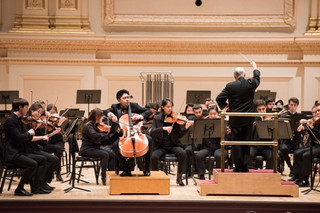|
Back
In One Era, Out The Other New York
Isaac Stern Auditorium, Carnegie Hall
02/24/2015 -
Steven Stucky: Dreamwaltzes
Dmitri Shostakovich: Cello Concerto No. 1 in E-flat Major, Opus 107
Richard Strauss: Ein Heldenleben, Opus 40
James Jeonghwan Kim (Cello)
Juilliard Orchestra, David Zinman (Conductor)

J. Kim, D. Zinman, Juilliard Orchestra (© Nan Melville)
”A composer in the late 20th century can admire the waltz from a distance; he cannot make it his own.”
James M. Keller, from program notes for Steven Stucky’s Dreamwaltzes
What Mr. Keller says about the waltz is true for any period, any music. You can’t go home again. You can’t turn the clock back to another century. Unlike Joshua, you can’t make time stand still.. Steven Stucky used two Brahms waltzes and one Richard Strauss waltz as the foundation for a 15-minute orchestral work of dazzling proportions. But this was neither a Ravel-style waltz apotheosis nor a Strauss Rosenkavalier homage.
True, both composers were on the very cusp of the composers with whom they were inspired. Mr. Stucky was born a mere two months after the death of Richard Strauss. Strauss was born two decades after the Figaro librettist Lorenzo da Ponte. But Strauss’s father, who had played French horn in Munich for many decades, was a true link to the days of Mozart.
(And I love the Da Ponte connection to New York, since he ended his happy long life teaching Italian at Columbia University and importing formaggio italiano).
Strauss, though, was unlike Stucky, in that he did think he could return to another time with that opera. In his logical German world, before Freud and Einstein, all he needed was Mozart’s spiritual guidance, his own inspiration, a lush late 19th Century orchestra, and unbridled passion, and he had his product.
Stucky lives in an age where every note is more than music. It has its own waves and particles, each note can split its infinite particles, it has a subconsciousness reflecting deeper elements of the composer himself.

S. Stucky (© www.presser.com)
So Steven Stucky’s Dreamwaltzes, the opening work of the Juilliard Orchestra under David Zinman last night, was a bit more complicated. As Mr. Keller said, one can no longer “dress up” another era. But a man of Mr. Stucky’s temperament can create a galvanizing picture of the waltz, harking back and forth through the centuries.
Unlike Strauss, another master orchestrator (as we heard later in the program), Mr. Stucky doesn’t need his full forces to make his statements. For the full quotes of Strauss and Brahms, he used the full orchestra in all its major-minor grandeur. But I have never heard a work of this composer which used a filler. All the sounds were picked precisely. His “particles” in between the sections were introduced with sensitive winds and bells. His waltz rhythms (ambiguous at best) seemed to come from the background, from separate instruments playing against one another.
I had never heard this very early work, written in 1986, but like all his music, Dreamwaltzes shows a pinpoint precision in his painting, making his points without forcing them, allowing his audience to force their own minds to meet his own pictures.
While the Juilliard Orchestra is a student orchestra, the students of Juilliard make up our great orchestras. Having a conductor like David Zinman conduct them brings out the best of every soloist, of the complete ensembles. And these three works were a joy to hear.
In the Strauss Ein Heldenleben (A Heros’s Life), these soloists were as good as in any orchestra. The offstage brass for the “war” played faultlessly. Concertmaster Wyatt Underhill played more than solo violin. It was a very personal picture he painted. At first, I thought, while his tone was very sweet, that the intonation was off. But perhaps this was because Mr. Zinman allowed him to give a saucy feeling to the violin, and this worked.
The only problem was that the Heldenleben score did have a monochromatic feeling when the orchestra was playing as a single ensemble. It’s difficult to escape this 19th Century German over-fullness, but certain orchestras, certain conductors can airbrush that massive sameness, giving at least the illusion of color. But in total. Zinman did produce a gratifying performance (and that climax, to me, is even greater than the introduction to Zarathustra).
The soloist of the evening was an already heralded cellist, James Kim. The young Korean (who, sitting, was almost eclipsed by his cello) gave a wonderfully stormy account of the Shostakovich First Cello Concerto. Stormy without the mania which its dedicatee Mstislav Rostropovich gave to the music. But that was Rostropovich, and there was no reason for Mr. Kim to try and imitate an artist of such a singular temperament.
Instead, Mr. Kim was deft, thunderous when needed, and in that extraordinary polyphonic cadenza, he did something rare. Yes, it was performed without a hitch, it was transparent, vital, lyrical. But Mr. Kim never seemed to find its agonizing difficulty. He never sculpted out its passions. Rather, he played that cadenza with a brooding, sensitive exceptional expression. With Mr. Zinman directing the complex orchestral part behind him, it was a noble and memorable performance.
Harry Rolnick
|